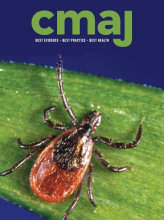About 20%–55% of patients admitted to hospital for coronavirus disease 2019 (COVID-19) have laboratory evidence of coagulopathy
Coagulopathy correlates with severity of COVID-19 and may include increased d-dimer concentrations (≥ 2 times above normal range), mildly prolonged prothrombin time (~ 1–3 s prolongation above normal range), mild thrombocytopenia (platelet count > 100 ×109/L) and, in late disease, decreased fibrinogen levels (< 2 g/L [5.88 μmol/L]).1–3 It is uncertain whether the observed coagulopathy is caused directly by the virus or is secondary to a proinflammatory state.
Elevated d-dimer concentration is associated with poor clinical outcomes
It is unclear how a d-dimer result should specifically be used in clinical care. However, an increased concentration at the time of hospital admission and throughout the hospital stay is associated with death,1,2 and a concentration 4 times above normal is associated with an approximately fivefold higher odds of critical illness than a normal d-dimer concentration (www.medrxiv.org/content/10.1101/2020.04.08.20057794v1.full.pdf).
COVID-19-associated coagulopathy appears to be prothrombotic
In 2 retrospective studies, venous thromboembolism was diagnosed in about 1 in 4 patients admitted to the intensive care unit with COVID-19.4,5 In 1 study, this occurred despite thromboprophylaxis with low-molecular-weight heparin.5 Available studies have not reported bleeding as a common complication, although the literature is evolving rapidly.2,4,5
In the absence of a contraindication, patients admitted to hospital should receive venous thromboembolism prophylaxis as per standard of care
Venous thromboembolism prophylaxis is recommended for most admitted patients, especially those with a proinflammatory state. In 1 retrospective study, patients with a d-dimer concentration 6 times above normal who received heparin thromboprophylaxis (mostly enoxaparin 40–60 mg/d) had lower mortality than those who did not receive thromboprophylaxis.6
Transfusion of blood products should be avoided in patients who do not have active, major bleeding
Transfusing with the aim of correcting only hemostatic laboratory parameters can be harmful (e.g., risk of transfusion reaction), regardless of whether the patient has COVID-19. Patients with active, major bleeding should be transfused appropriately as per local protocol.
CMAJ invites submissions to “Five things to know about …” Submit manuscripts online at http://mc.manuscriptcentral.com/cmaj
Footnotes
Competing interests: Michael Fralick is a co-investigator and Michelle Sholzberg is a principal investigator on a clinical trial involving patients with COVID-19 coagulopathy. No other competing interests were declared.
This article has been peer reviewed.








